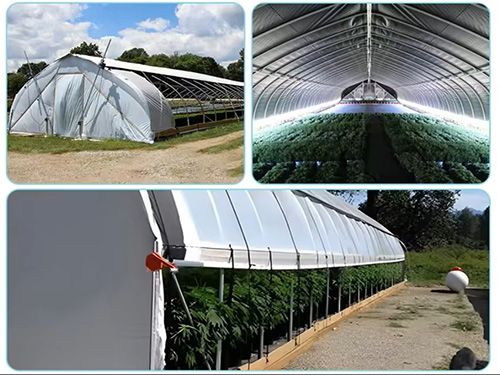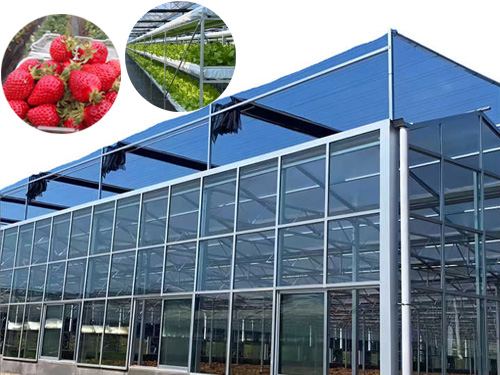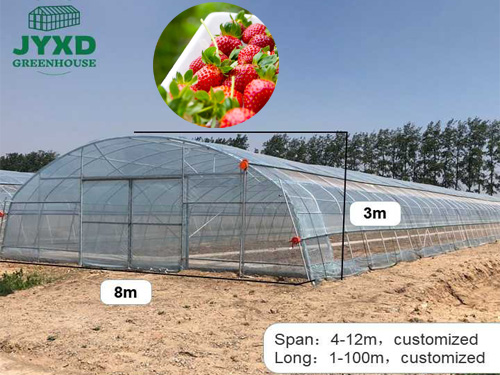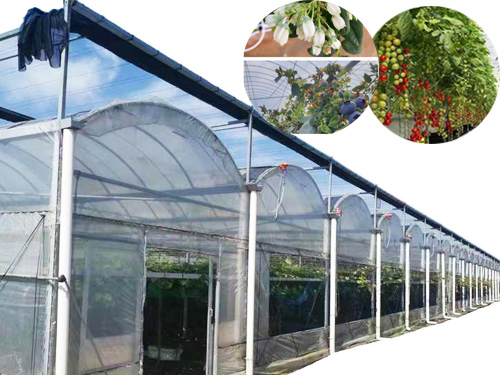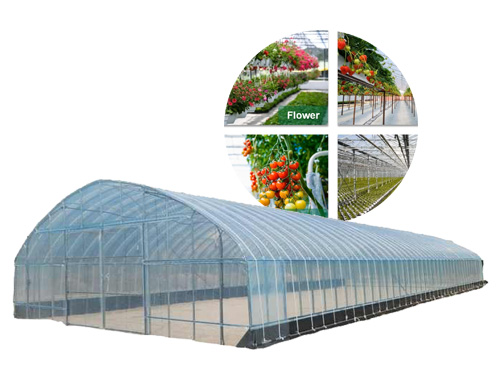NEWS DETAILS
NEWS INFORMATION
Managing Harsh Climate Conditions in Greenhouses: Strategies for a Stable Environment
AUTHOR:jyxd-greenhouse DATE:2025-03-14 20:02:36 HITS:111
Greenhouses are essential for growing plants in controlled environments, especially in regions with extreme weather conditions. However, managing these environments can be challenging when dealing with harsh climates such as extreme heat, cold, humidity, or fluctuating weather patterns. Maintaining a stable environment inside a greenhouse is crucial to ensure healthy plant growth and optimal yields. In this article, we will explore strategies for managing harsh climate conditions in greenhouses, ensuring that plants thrive regardless of external weather challenges.
1. The Impact of Harsh Climate on Greenhouse Environments
Harsh climate conditions can significantly impact the internal environment of a greenhouse. Temperature fluctuations, high humidity levels, intense sunlight, or freezing temperatures can all disrupt plant growth and development. Some of the key issues caused by harsh climates include:
• Temperature Extremes: Excessive heat or cold can stress plants, leading to poor growth, wilting, or even death in extreme cases. Plants may not be able to absorb nutrients effectively when temperatures are too high or low.
• Humidity Imbalances: High humidity can lead to mold, mildew, and fungal diseases, while too little moisture can cause plants to dry out. Both extremes can be harmful to plant health.
• Inconsistent Light: In regions with intense sunlight or limited daylight hours, plants may suffer from light stress, either from overheating or insufficient light for photosynthesis.
• Wind and Storms: High winds, hail, or snowstorms can damage the greenhouse structure or cause debris to hit plants, affecting growth.
2. Strategies for Temperature Control in Greenhouses
One of the most critical factors in greenhouse management is controlling temperature. Whether it’s protecting plants from freezing temperatures in the winter or preventing overheating in the summer, maintaining the right temperature range is essential. Here are effective strategies for managing temperature extremes:
2.1. Use Shade Nets and Screens
In areas with excessive sunlight or heat, using shade nets or screens can help reduce the amount of direct sunlight that enters the greenhouse. These materials can reduce internal temperatures, prevent overheating, and protect plants from sunburn. Shade nets come in various levels of opacity, allowing you to control the amount of light entering the greenhouse.
2.2. Install Cooling Systems
Cooling systems such as evaporative coolers or wet wall systems are essential in hot climates. These systems work by introducing cool water into the air, reducing temperature and humidity levels inside the greenhouse. Fans or exhaust systems can help circulate the air and prevent hot air from becoming trapped inside.
2.3. Incorporate Insulation and Double Glazing
In cold climates, insulation is essential to maintain a stable temperature inside the greenhouse. Using double-glazed glass or polycarbonate panels can help retain heat during the winter and provide insulation against extreme cold. Additionally, insulating the greenhouse structure and floors can prevent heat loss, ensuring a more consistent internal temperature.
2.4. Automated Temperature Control Systems
Investing in automated temperature control systems is an effective way to manage temperature fluctuations. These systems use sensors to monitor the internal temperature and adjust the heating or cooling systems as needed. This ensures that the greenhouse maintains an optimal temperature range for plant growth at all times, without the need for constant manual adjustments.
3. Humidity Control Strategies
Maintaining the right humidity level is crucial for plant health, as both excessive moisture and low humidity can lead to problems. In high humidity environments, plants are at risk of developing mold, mildew, and fungal infections, while low humidity can cause dehydration and stress. Here are strategies for managing humidity in your greenhouse:
3.1. Use Dehumidifiers or Ventilation Systems
Dehumidifiers are essential in areas with high humidity levels, helping to reduce excess moisture in the air. In addition to dehumidifiers, proper ventilation is critical for managing humidity levels. Using passive or active ventilation systems, such as roof vents or side vents, allows fresh air to flow in while expelling excess moisture and warm air.
3.2. Install Humidification Systems
In dry climates or during winter months, it may be necessary to introduce additional moisture into the air to prevent plants from drying out. Automated humidification systems, such as misting or fogging systems, can maintain the desired humidity levels and prevent plants from experiencing dehydration stress.
3.3. Use Temperature and Humidity Monitors
Installing temperature and humidity monitors throughout the greenhouse can help you keep track of the internal conditions. These devices provide real-time data, allowing you to make timely adjustments to your heating, cooling, or humidification systems to maintain a balanced environment.
4. Light Management in Extreme Climates
Managing light levels in greenhouses is crucial, particularly in areas with long winters or intense sunlight. Both too little and too much light can stress plants. Here are strategies to manage light conditions in your greenhouse:
4.1. Use Light Diffusing Materials
In regions with intense sunlight, using light-diffusing materials such as diffusing films or shade nets can help prevent direct sunlight from overheating the greenhouse. These materials scatter light evenly across the plants, reducing the risk of heat stress while still providing the necessary light for photosynthesis.
4.2. Install Supplemental Lighting
In areas with limited daylight or long winters, supplemental lighting can ensure that plants receive enough light for growth. LED or fluorescent lights can be used to extend the daylight hours or provide consistent light levels during the darker months. Be sure to use energy-efficient lighting systems to minimize costs and reduce the environmental impact.
4.3. Optimize Plant Placement
Consider the placement of plants in your greenhouse to ensure they receive the right amount of light. Place light-sensitive plants in areas with controlled light levels, such as shaded spots or near supplemental lights. Grouping plants with similar light requirements together can help optimize their growth.
5. Wind and Storm Protection
In areas prone to high winds, storms, or hail, it is essential to protect the greenhouse and plants from potential damage. Here are effective strategies for minimizing wind and storm damage:
5.1. Reinforce the Greenhouse Structure
Ensure that the greenhouse frame is strong and stable enough to withstand harsh weather conditions. Use durable materials such as galvanized steel or aluminum for the frame, and regularly inspect and maintain the structure to prevent wear and tear.
5.2. Install Storm Screens or Barriers
Installing storm screens or barriers around the greenhouse can provide extra protection during severe weather. These screens can help shield the greenhouse from hail, flying debris, and high winds. Be sure to use materials that can withstand the specific conditions in your area.
5.3. Use Automatic Shutters
Automatic shutters or roll-up sides can be employed to close the greenhouse during extreme weather, protecting both the structure and plants from storm damage. These shutters can be controlled remotely, ensuring that your greenhouse is securely protected during a storm.
6. Conclusion
Managing harsh climate conditions in greenhouses is essential for creating a stable environment that supports healthy plant growth and high yields. By implementing temperature control systems, managing humidity levels, optimizing light, and protecting the greenhouse structure, you can mitigate the effects of extreme weather and ensure that your plants thrive. Regular monitoring and maintenance, combined with proactive strategies for controlling climate variables, will provide the best conditions for sustainable and successful greenhouse farming. If you need help with greenhouse climate control solutions, contact us for expert advice and high-quality products tailored to your needs.
Hebei Juyou Xinda Greenhouse Facilities Co.,Ltd.
Copyright © 2024-2025 https://www.jyxd-greenhouse.com. All Rights Reserved Hebei Juyou Xinda Greenhouse Facilities Co.,Ltd.Copyright





 Current Location:
Current Location:


